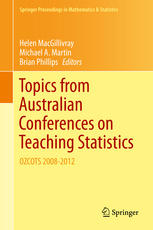

Most ebook files are in PDF format, so you can easily read them using various software such as Foxit Reader or directly on the Google Chrome browser.
Some ebook files are released by publishers in other formats such as .awz, .mobi, .epub, .fb2, etc. You may need to install specific software to read these formats on mobile/PC, such as Calibre.
Please read the tutorial at this link: https://ebookbell.com/faq
We offer FREE conversion to the popular formats you request; however, this may take some time. Therefore, right after payment, please email us, and we will try to provide the service as quickly as possible.
For some exceptional file formats or broken links (if any), please refrain from opening any disputes. Instead, email us first, and we will try to assist within a maximum of 6 hours.
EbookBell Team

4.3
88 reviewsThe first OZCOTS conference in 1998 was inspired by papers contributed by Australians to the 5th International Conference on Teaching Statistics. In 2008, as part of the program of one of the first National Senior Teaching Fellowships, the 6th OZCOTS was held in conjunction with the Australian Statistical Conference, with Fellowship keynotes and contributed papers, optional refereeing and proceedings. This venture was so successful that the 7th and 8th OZCOTS were similarly run, conjoined with Australian Statistical Conferences in 2010 and 2012. Authors of papers from these OZCOTS conferences were invited to develop chapters for refereeing and inclusion in this volume. There are sections on keynote topics, undergraduate curriculum and learning, professional development, postgraduate learning, and papers from OZCOTS 2012. Because OZCOTS aim to unite statisticians and statistics educators, the approaches this volume takes are immediately relevant to all who have a vested interest in good teaching practices. Globally, statistics as a discipline, statistical pedagogy and statistics in academia and industry are all critically important to the modern information society. This volume addresses these roles within the wider society as well as questions that are specific to the discipline itself. Other chapters share research on learning and teaching statistics in interdisciplinary work and student preparation for futures in academia, government and industry.